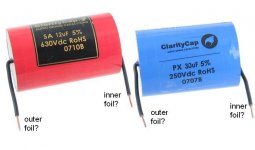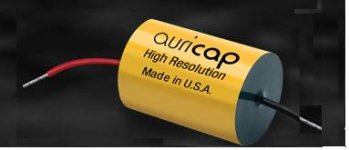OK, so...
If I understand you, when reading the label:"Clarity Cap" the left-hand lead (closest to the "C" in Clarity) is probably the OUTER FOIL lead, and should be connected to the input, while the right hand lead (closest to the "p" in Cap) is the inner foil and should go towards the tweeter + terminal... Right?
Has anyone else found this?
Joe
If I understand you, when reading the label:"Clarity Cap" the left-hand lead (closest to the "C" in Clarity) is probably the OUTER FOIL lead, and should be connected to the input, while the right hand lead (closest to the "p" in Cap) is the inner foil and should go towards the tweeter + terminal... Right?
Has anyone else found this?
Joe
Attachments
Subjectivist nonsense
Proper orientation of non-polarized/film caps?!? Subjectivist nonsense.
Please, oh please do some honest double-blind listening tests and you will instantly realize there is absolutely no audible difference between decent film caps with similar ratings. There is also no audible difference between DC and AC coupled amps and preamps.
Time smear?!? OMFG – the ridiculousness goes on. . .
99.99% of every piece of audio equipment you have ever heard, including the equipment that recorded your reference music, is in all likelihood AC coupled or has caps in and/or bypassing signals. You really think 99.99% of all audio gear on the planet, including in recording studios, sounds bad or “time smeared”? You must also think you’re sane and 6.5 billion humans on earth are crazy.
Show me numbers, curves, traces, or test fixtures, not anecdotal silliness.
Proper orientation of non-polarized/film caps?!? Subjectivist nonsense.
Please, oh please do some honest double-blind listening tests and you will instantly realize there is absolutely no audible difference between decent film caps with similar ratings. There is also no audible difference between DC and AC coupled amps and preamps.
Time smear?!? OMFG – the ridiculousness goes on. . .
99.99% of every piece of audio equipment you have ever heard, including the equipment that recorded your reference music, is in all likelihood AC coupled or has caps in and/or bypassing signals. You really think 99.99% of all audio gear on the planet, including in recording studios, sounds bad or “time smeared”? You must also think you’re sane and 6.5 billion humans on earth are crazy.
Show me numbers, curves, traces, or test fixtures, not anecdotal silliness.
you're missing a point there, "direction" of a film cap refers to actual construction assymetry - one foil/electrode is on the "outside"
this is a real issue with film caps; being physically large they can be good electric field pickups
the outer foil's terminal should be connected to the lower impedance node to reduce its effect as an electric field reciever antenna and so it serves as a electric field sheid for the more sensitve high impedance node
this is a real issue with film caps; being physically large they can be good electric field pickups
the outer foil's terminal should be connected to the lower impedance node to reduce its effect as an electric field reciever antenna and so it serves as a electric field sheid for the more sensitve high impedance node
>one foil/electrode is on the "outside"
True point and easily demonstrated. Connect a small valued film capacitor as the shunt capacitor of a low-pass filter, with a highish valued series resistor as the series element (and with the filter driving a high impedance load such as a power amp input). Listen to what comes out when you lay your finger against the side of the cap: with one orientation you'll be able to induce hum from your body pickup, with the other you won't be able to.
Whether that will matter in most uses is another thing. Power supply bypasses, series blocking caps with very low cutoffs (big caps) likely won't care about orientation.
True point and easily demonstrated. Connect a small valued film capacitor as the shunt capacitor of a low-pass filter, with a highish valued series resistor as the series element (and with the filter driving a high impedance load such as a power amp input). Listen to what comes out when you lay your finger against the side of the cap: with one orientation you'll be able to induce hum from your body pickup, with the other you won't be able to.
Whether that will matter in most uses is another thing. Power supply bypasses, series blocking caps with very low cutoffs (big caps) likely won't care about orientation.
Re: Spraque Extralytic
Josh,
cap looks legit to me. why would you think it's not? Extralytic series is a legit series by Sprague.
bluevas said:Hi guys,
I plan to build Le Monstre and Mini Aleph. I find this SPRAQUE EXTRALYTIC 180000uf 30 VDC. Is this genuine or fake?
Thank you Gentlemen,
Best Regard,
Josh
Josh,
cap looks legit to me. why would you think it's not? Extralytic series is a legit series by Sprague.
- Status
- Not open for further replies.
- Home
- General Interest
- Everything Else
- Sound of Capacitors

